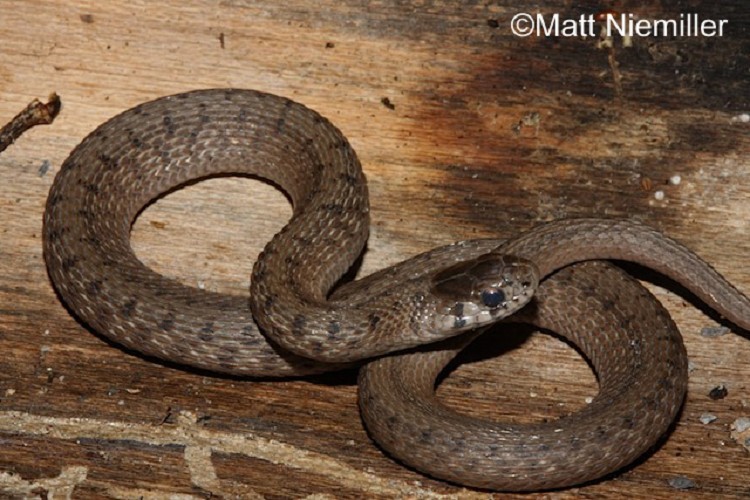DeKay’s Brownsnake, Storeria dekayi
There are 2 subspecies of this secretive snake in Tennessee: Midland Brownsnake (S. d. wrightorum), which occurs across most of the state, and Northern Brownsnake (S. d. dekayi), which occurs in the southeastern quarter of the state (where the two subspecies interbreed as well).
Description: A small, keel-scaled snake (9.0 to 13.0 inches in length) with variable coloration. Dorsal color can be gray, brown, or reddish-brown with 2 parallel rows of dark spots down the back (spots are connected by a narrow brown crossline in the Midland Brownsnake).
The top of the head is dark and a dark, downward streak occurs on each side of the head. Belly is yellowish, tan, or pinkish with very small black dots on the sides. Young are much darker with faint spots and have a conspicuous yellowish collar across neck.
Similar Species: Ring-necked Snakes have smooth scales and yellow bellies with paired dots down the center. Eastern Gartersnakes have a light stripe on each side of the body. Red-bellied Snakes normally have a red belly. Eastern Wormsnakes have smooth scales. Rough and Smooth Earthsnakes have a long, horizontal loreal scale.
Habitat: Occurs in a variety of habitats. DeKay’s Brownsnake prefers moist environments in pine or hardwood forests, river floodplains, urban areas, or edges of wetlands. Often found in gardens, rock piles, wood piles, cemeteries, parks, and empty lots.
Diet: Includes earthworms, snails, spiders, soft-bodied insects, small amphibians, and fish.
Breeding information: Generally mates and breeds in the spring, but fall breeding can occur. Females give live birth (ovoviviparous) to an average litter of 13 (range 3-41) during late summer. No parental care after they are born.
Status in Tennessee: Common and widely distributed in the state; this species does well in suburban and urban habitats so no conservation concern.
Fun Facts:
- Named after James Edward DeKay, who was an 19th century naturalist and writer in New York.
Best places to see in Tennessee: Under rock or stone piles in a moist site, particularly in abandoned parking lots.
